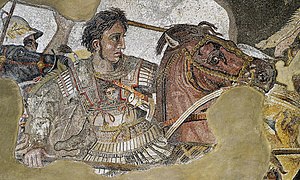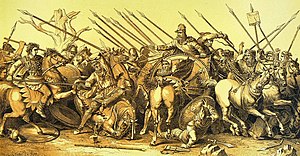User:Kparsa/sandbox2
New sandbox
This article needs additional citations for verification. (May 2013) |
| Alexander Mosaic | |
|---|---|
 | |
| Artist | Unknown |
| Year | c. 100 BC |
| Type | Mosaic |
| Dimensions | 272 cm × 513 cm (8 ft 11 in × 16 ft 9 in) |
| Location | National Archaeological Museum, Naples |
The Alexander Mosaic, dating from circa 100 BC, is a Roman floor mosaic originally from the House of the Faun in Pompeii.[1] It depicts a battle between the armies of Alexander the Great and Darius III of Persia and measures 2.72 by 5.13 metres (8 ft 11 in × 16 ft 10 in).[2] Without the frame around the mosaic, it can occupy most of the floor space. The original is preserved in the Naples National Archaeological Museum. Badly damaged during the 62 AD earthquake in Pompeii, the Alexander mosaic was reconstructed with plaster, but got buried in the eruption of Mt. Vesuvius in 79 AD. It was rediscovered in the year 1831.[3]
Production[edit]
The reason behind constructing as mosaic on the floor was low mosaic technique cost.[3] The mosaic is made of about one and a half million tiny colored tiles called tesserae, arranged in gradual curves called opus vermiculatum, (also known as "worm work," because they seem to replicate the slow motion of a crawling worm). The color scale of Roman mosaics are extremely rich in gradation. The process of gathering materials for mosaics was a complex undertaking since the color scale was based solely off of the pieces of marble that could be found in nature.[4] The mosaic is an unusually detailed work for a private residence and was likely commissioned by a wealthy person or family. The fact that this scene was made to be viewed in the house of a Roman civilian reveals that Alexander the Great was more than just a heroic image to the Romans. Because Roman leaders followed after Alexander's image, Roman civilians also aspired to emulate the power he represented.[5] Since the mosaic was arranged on the floor where the patron would receive his guests, it was the first decorative object a visitor would see upon entering the home. The mosaic was purposefully placed in the entrance way so that guests would immediately be able to discern the status and personality of the owner even before they entered the home.[6]
Composition and Techniques[edit]
In the mosaic, Alexander is charging from left with his eyes targeting the prince of Persia. In Alexander forefront , an victim Parisian soldiers filled with blood is falling from his horse to save his king to be killed. Over to the right hand side, Darius, the king of Persia, is standing high in his chariot reaching out with his worried facial expression of being killed. The horse that Darius is riding on looks like going to fall on the ground which creates an action of Darius falling in any moment. In the background known warriors are fighting with spears flying up in the air.[7]
Radical foreshortening – as in the central horse, seen from behind – and the use of shading to convey a sense of mass and volume enhance the naturalistic effect of the scene. Repeated diagonal spears, clashing metal, and the crowding of men and horses evoke the din of battle. At the same time, action is arrested by dramatic details such as the fallen horse and the Persian soldier in the foreground who watches his own death throes reflected in a shield.
Subject[edit]
The mosaic illustrates a battle in which Alexander faced and attempted to capture or kill Darius. Alexander defeated him at the Battle of Issus and two years later at the Battle of Gaugamela. The work is traditionally believed to show the Battle of Issus.[8] Through this subject matter, the mosaic represent political vision of Alexander during the time. It also displays narrative of historical action.[3] According to Greek accounts, Darius was successful in escaping the losing battle. However, Alexander was able to kill Darius's horse with a well-aimed shot. [3] In the end, after the escape of Darius from the battle, Alexander may have turned around to chase Darius or he might have carried on with battle.[7] However, the hand gesture of Darius toward Alexander can suggest offering peace and friendship toward him after battle.[7]
Since the mosaic emulates the appearance of a painting so accurately, it has been uniformly agreed that the mosaic is a copy of an original Hellenistic Greek painting.[9] The mosaic is held to be a copy either of a painting by Aristides of Thebes, or of a lost late 4th-century BC fresco by the painter Philoxenus of Eretria.[10] The latter is mentioned by Pliny the Elder (XXXV, 110) as a commission for the Macedonian king Cassander.[11]The mosaic's dramatic quality represent the rich culture which roots from Homeric poetry. It shows a paradigmatic and economically enactment of hierarchy and interplay of status.[3]
Alexander and Darius[edit]


The two main figures :-
- The portrait of Alexander is one of his most famous. Alexander's breastplate depicts Medusa, the famous Gorgon, and his wavy hair is typical of royal portraiture as established in Greek art of the fourth century BC. He is portrayed sweeping into battle at the left, on his famous horse, Bucephalus,[12] and focusing his gaze on the Persian leader.
- Darius is shown in a chariot. He seems to be desperately commanding his frightened charioteer to flee the battle, while stretching out his hand either as a mute gesture to Alexander, or possibly after throwing a javelin. He has a worried expression on his face, portraying a coward king.[3]The charioteer is whipping the horses as he tries to escape. The Persian soldiers behind him have expressions of determination and consternation.
Darius's Brother[edit]
Darius's brother Oxyathres is also portrayed, sacrificing himself to save the King.
Interpretation[edit]
The mosaic is a glamorous presentation of Alexander's victory. It has both religious and political factors to it. The dominating position and posture of Alexander represent his position of power during a turbulent time. The subject of political tension has been portrayed through the bold facial expression of Alexander with Darius' fearful and concerned face.[13]
The mosaic has mixture of Italian, Hellenistic and Roman traditions. The mosaic is also believed to be a copy of an early 3rd-century or late fourth century BC Hellenistic painting.[14] Later scholars found that this work of art is Greek because the subject matter shows the battle between Greek army and Persians accord in fourth century BC. However, based on the fact presented that still this mosaic is unknown in regard of its original place and the reason why it was created. [15][16]
In addition, this work of art is thought to be inspired by Homer's metaphoric description of the death of Simoeisios at Troy as the felling of a mighty poplar. This poem is comparing the fall of mortals and empires to the withering and falling of the leaves.[7] This metaphor was also commonly portrayed in Greek vase. The connection between the mosaic and the metaphor is the Persian empire's downfall during Alexander's rule. [7]
History of the mosaic[edit]
Modern history[edit]
The mosaic was rediscovered on October 24, 1831 in Pompeii, and was moved to Naples in September 1843, where it is currently preserved on a wall (not on a floor as it was found) in the Museo Archeologico Nazionale. The mosaic is featured on 1,000 Greek drachma banknotes from 1956.[17]
Modern copy[edit]

In 2003 the International Center for the Study and Teaching of Mosaic (CISIM) in Ravenna, Italy, proposed to create a copy of the mosaic.[18] When they had received approval, the mosaic master Severo Bignami and his eight-person team took a large photograph of the mosaic, made a tracing of the image with a dark marker and created a negative impression of the mosaic.
The team composed the mosaic in sections in 44 clay frames, trying to preserve the pieces of the mosaic in the exact positions they are in the original mosaic. They had to keep the plates wet all the time. Then they pressed a tissue on the clay to create an image of the outlines of the mosaic in the clay. The team recreated the mosaic with about 2 million pieces of various marble types. When they had placed all the pieces, they covered the result with a layer of glue and gauze and pulled it out of the clay. They placed each section on synthetic concrete and then united the sections with the compound of glasswool and plastic.
The project took 22 months and a cost equivalent to US $216,000. The copy was installed in the House of the Faun in 2005.
Gallery[edit]
-
Close up of Alexander.
-
Close up of Darius.
-
Centre detail of the Mosaic.
-
Detail of the Persians on the right side of the Mosaic.
-
Detail of a fallen sword from the bottom right of the Mosaic (showing the individual tesserae).
References[edit]
| External videos | |
|---|---|
- ^ European History, Alexander the Great, The Battle of Issus
- ^ Honour, H. and J. Fleming, (2009) A World History of Art. 7th edn. London: Laurence King Publishing, p. 178. ISBN 9781856695848
- ^ a b c d e f Cohen, Ada (January 28, 2000). The Alexander Mosaic: Stories of Victory and Defeat (Cambridge Studies in Classical Art and Iconography). Cambridge University Press. pp. 302 pages. ISBN 0521775434.
- ^ Davies, Penelope JE; et al. (2007). Janson's History of Art. New Jersey: Prentice Hall. p. 246. ISBN 978-0135006887.
- ^ Davies, Penelope JE; et al. (2007). Janson's History of Art. New Jersey: Prentice Hall. p. 146. ISBN 978-0135006887.
- ^ Wallace-Hadrill, Andrew (1994). Houses and Society in Pompeii and Herculaneum. p. 3.
- ^ a b c d e Stewart, Andrew. ""The Alexander Mosaic: A Reading"". Faces of Power: Alexander's Images and Hellenistic Politics: 130–150.
- ^ Battle of Issus, History.com
- ^ L'Orange and Nordhagen, Hans Peter and Per Jonas (1966). Mosaics. Great Britain. p. 8.
{{cite book}}: CS1 maint: location missing publisher (link) - ^ Alexander Mosaic by Dr. Beth Harris and Dr. Steven Zucker, Smarthistory, 2013. Retrieved 26 May 2013.
- ^ Kleiner, Fred S. (2008). Gardner's Art Through the Ages: A Global History. Cengage Learning. p. 142. ISBN 978-0-495-11549-6.
- ^ Winkes, Rolf: "Bukephalas”, Archaeologia Transantlantica XVIII, 2000, 101-107
- ^ Giltzow, C., & Gamon, Patricia B. (2010). Comparison between “The Alexander Mosaic” in Pompeii and “The Justinian and Attendants Mosaic” in Ravenna, Italy, ProQuest Dissertations and Theses.
- ^ Woodford, Susan. (1982) The Art of Greece and Rome. Cambridge: Cambridge University Press, p. 67. ISBN 0521298733
- ^ Cohen, Ada (28 January 2000). The Alexander Mosaic: Stories of Victory and Defeat. ISBN 0521775434.
- ^ Cohen, Ada (2000-01-28). The Alexander Mosaic: Stories of Victory and Defeat. Cambridge: Cambridge University Press. ISBN 9780521775434.
- ^ "16.04.1956: Alexander the Great in Modern Greek Bank Note of one thousand Drachmas=". History of Macedonia. Retrieved 16 Aug 2015.
- ^ Alexander, Piece by Piece. by Marco Merola, Archaeology, Abstracts Vol. 59, No. 1, Jan/Feb 2006. Retrieved 26 May 2013. Archived here.





